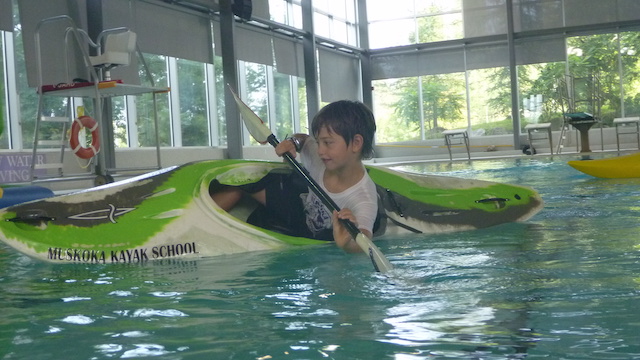Getting kids into kayaks, let alone practicing skills in them, parents and adults have to lead the way by example. When Andy Parry is in his kayak, he acts like a big kid. With high energy and a contagious smile he blends into the swarm of kids that paddle and play around him.
Born and raised in the UK, Parry paddled at the national and international level and is now a Physical Education teacher, with a degree in Sports Coaching. He is the owner and main instructor for the Muskoka Kayak School where he incorporates fun and learning into each session on the water. When it comes to paddling with kids, laughter and goofing around are all part of the lesson. Parry shares his knowledge – as a professional coach but also as a father – on how to get kids in, on and around whitewater.
BRING A FRIEND
“I think the key is getting youngsters in paddling is to have their friends there too,” says Parry. “It’s such a social thing for them.” Being on the water with friends helps diminish fear and apprehension and also helps with progression.
“Kids that are of the same ability start to push each other more to progress. Kayaking is no different than any other sport–making sure they have friends to paddle with them is so important,” he says.
FOCUS ON FUN, NOT WHITEWATER
Parry now calls Port Sydney, Ontario home and paddles there with his eight-year-old son and five-year-old daughter. “The first time the kids got in kayaks was on the river,” says Parry, referring to a section of slow, moving water along the Muskoka River where he holds many lessons. When you get on the river with kids, make sue the focus is fun. “Take their mind off being in whitewater,” says Parry. “The key is to make it normal for them. Don’t make a big deal. Don’t worry about it and don’t be scared yourself. If it’s scary to you, then they take on that fear.”
Substitute the bigger, more technical whitewater you like to paddle for something more forgiving and gentle. “Take them places that aren’t scary, don’t take them places you want to go,” Parry suggests. “You (the parents) need to be okay with not having any fun yourself – you have to take on their fun, to eat their fun.”
Parry’s son Daniel paddled the gentle whitewater of Palmer Rapids on own at six.
GEARING ‘EM UP
Paddling gear for growing kids can be costly. But the proper gear is important for a good day on the water. “Boats are really important,” says Parry. “They can’t be small adult boats, they need to fit the children. But then you are talking expense.”Parry does not encourage parents to go out and buy new boats. In fact he doesn’t approve of kids paddling new kayaks. But he does recognize that kid-sized boats are hard to come by, especially if there isn’t a whitewater club nearby. Affordable alternatives are becoming more common. “Not many people know that the Daggar Axiom 6.9 exists,” say Parry of the youth-size whitewater boat.
Paddles and proper layering is also important. “Hand size and grip size are really important when it come to paddles,” he says. “It should feel like you are holding a teaspoon when you pick up a kids paddle.” Layers of non-cotton clothing are vital to keeping kids warm on the water. “Spray skirts…don’t bother,” says Parry. “They don’t need it.” He gives his students the option but feels that they skirts can sometimes contribute to fear.
POOLS, ROLLS AND WHITEWATER
Encouraging you child to get comfortable on whitewater can be done very informally. “Find some moving water where they barely notice that it’s moving and they just learn to adapt to the water,” says Parry. Kids begin learning to read water by feel, without knowing it. “If they are in a suitable boat, in a suitable river then kids are often better than adults,” he says with regards to whitewater newbies.
“They will have mega amounts of fun on the tiniest amount of whitewater that you wouldn’t even notice.”
If winter has set in, or whitewater is far away, hit the pool. “Pool sessions provide a warm and user-friendly environment to practice all skills,” he says. Play around. Make your own fun. “Just play with the boats: on, in, around them,” he says. “Fill them up with water. It all builds confidence and that in turn builds confidence in whitewater.”
When do you start teaching kids to roll? “When they ask,” say Parry. “If you teach them to roll, that’s all they will end up doing. If you teach them to stay upright, that’s what they’ll do. And that’s what we want!”
“If they have friends to paddle with them and you can keep them warm, then normally, they make their own fun!” Try Parry’s approach. If you can think like a kid, paddle like a kid and show them how much fun whitewater is, you will be on your way to raising a life-long paddler.




